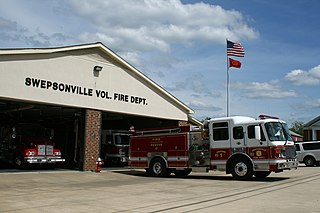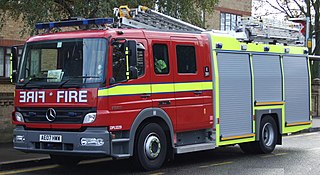Related Research Articles

A fire department or fire brigade, also known as a fire authority, fire district, fire and rescue, or fire service in some areas, is an organization that provides fire prevention and fire suppression services.

A volunteer fire department (VFD) is a fire department of volunteers who perform fire suppression and other related emergency services for a local jurisdiction. Volunteer and retained (on-call) firefighters are expected to be on call to respond to emergency calls for long periods of time, and are summoned to the fire station when their services are needed. They are also expected to attend other non-emergency duties as well.

The Fire Brigades Union (FBU) is a trade union in the United Kingdom for wholetime firefighters, retained firefighters and emergency control room staff.

Matthew D. Wrack is a British trade unionist and former firefighter. He was elected General Secretary of the Fire Brigades Union (FBU) in May 2005.

The London Fire Brigade (LFB) is the fire and rescue service for London, the capital of the United Kingdom. It was formed by the Metropolitan Fire Brigade Act 1865, under the leadership of superintendent Eyre Massey Shaw. It has 5,992 staff, including 5,096 operational firefighters and officers based at 102 fire stations.

For centuries, firefighters have worn helmets to protect them from heat, cinders and falling objects. Although the shape of most fire helmets has changed little over the years, their composition has evolved from traditional leather to metals, to composite helmets constructed of lightweight polymers and other plastics.
Chief fire officer (CFO), formerly often just chief officer, is the highest rank in the fire and rescue services of the United Kingdom. There are currently 50 chief fire officers serving in the United Kingdom in charge of the local authority fire services. There is also a chief fire officer responsible for the Ministry of Defence Fire Services, which includes the Defence Fire and Rescue Service and the RAF Fire Service. Some UK airport fire services also designate their seniors officers as CFOs, though these officers rarely wear the same rank insignia as a local authority chief fire officer.
As firefighting has a rich history throughout the world, traditions in this profession vary widely from country to country.

The history of organized firefighting began in ancient Rome while under the rule of Augustus. Prior to that, Ctesibius, a Greek citizen of Alexandria, developed the first fire pump in the third century BC, which was later improved upon in a design by Hero of Alexandria in the first century BC.

The fire services in the United Kingdom operate under separate legislative and administrative arrangements in England and Wales, Northern Ireland, and Scotland.
The following outline is provided as an overview of and topical guide to firefighting:

The West Yorkshire Fire and Rescue Service (WYFRS) is the county-wide, statutory emergency fire and rescue service for the metropolitan county of West Yorkshire, England. It is administered by a joint authority of 22 people who are appointed annually from the five metropolitan boroughs of West Yorkshire, known as the Fire and Rescue Authority.

Kent Fire and Rescue Service is the statutory fire and rescue service for the administrative county of Kent and the unitary authority area of Medway, covering a geographical area south of London, to the coast and including major shipping routes via the Thames and Medway rivers. The total coastline covered is 225 km ; it has 55 fire stations, and four district fire safety offices. The FRS provides emergency cover to a population of nearly 2 million.

The National Fire Service (NFS) was the single fire service created in Great Britain in 1941 during the Second World War; a separate National Fire Service was created in 1942.

The National Firefighters Memorial is a memorial composed of three bronze statues depicting firefighters in action at the height of the Blitz. It is located on the Jubilee Walkway to the south of St Paul's Cathedral in the City of London, and it is approachable from the south bank of the River Thames via the Millennium Footbridge.

Firefighting has historically been a predominantly male profession throughout the world. However, since the 1970s, women have made inroads in both professional and volunteer fire departments in multiple countries. In modern times, women have served in a variety of fire service roles including as fire chiefs. Nonetheless, they comprise less than 20% of firefighters even in the countries where they are best represented.

Cornwall Fire and Rescue Service is the statutory fire and rescue service covering Cornwall, England. As of April 2019, the service employs over 400 retained firefighters, 203 full-time firefighters, plus 170 support and administrative staff. Created under the Fire Services Act 1947 as "Cornwall Fire Brigade", the name changed to "Cornwall Fire and Rescue Service" on 1 October 2009.
Firefighting is the act of extinguishing destructive fires. A firefighter fights these fires with the intent to prevent destruction of life, property and the environment. Firefighting is a highly technical profession, which requires years of training and education in order to become proficient. A fire can rapidly spread and endanger many lives; however, with modern firefighting techniques, catastrophe can usually be avoided. To help prevent fires from starting, a firefighter's duties include public education and conducting fire inspections. Because firefighters are often the first responders to victims in critical conditions, firefighters often also provide basic life support as emergency medical technicians or advanced life support as licensed paramedics. Firefighters make up one of the major emergency services, along with the emergency medical service, the police, and many others.
Steve (Stephen) Dudeney is a retired British firefighter. He was a senior officer in the London Fire Brigade.